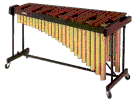While it is important to like and dislike pieces, first consider the difficulty level when choosing a piece.
Many teachers choose pieces from TV shows and movies because "students know them," but students only know the melody. If you don't check the parts other than the melody carefully, the rhythm and chords of the accompaniment may be difficult.
In most cases, bands (teachers) who aren't doing well choose songs that are too difficult.
A good guideline is to be able to play it after just a few practice sessions. If you can't pass the piece, it's simply too difficult for that band.
Some sheet music indicates the difficulty level of performance, but this is only a guide.
A piece is easy for one band may be difficult for another band, and there are times when the part with the important melody in the piece is not able to produce the sound because students who have just started playing a instrument this year are gathered there.
First, make sure that the range of the trumpet, horn, flute, or clarinet is not too wide (or too high). Make sure you understand what range your band practice in your regular basic practice and what range the students can play.
Also, fast-moving parts are difficult for any instrument. Think carefully about the current level of skill of your band and avoid pieces that are too difficult.
Always choose and practice pieces that are appropriate for the level of the entire band at that time.
Difficult piece is not always good piece, and bands that can play difficult pieces are not always good bands. The most important thing is to match the level of the band.
Students change every year. Think about the pieces you choose so that students can experience at least 10 to 20 different types of pieces (classical, jazz, Latin, children's songs, popular, etc.) in a year.
Also, choose a good balance between pieces that sing melodies at a slow tempo and pieces that are faster and rhythmic. The Brass Band Arrangements are arrangements of various styles of songs, one chorus at a time, in an easy-to-play range. Try to play as many songs as possible.
I have seen many schools that have many marimbas (xylophones)
 but do not use them. If there are several students who play percussion instruments, pieces can be played using only keyboard percussion instruments (xylophones, glockenspiels, marimbas, etc.). Two people can use one marimba, which has a wide range.
but do not use them. If there are several students who play percussion instruments, pieces can be played using only keyboard percussion instruments (xylophones, glockenspiels, marimbas, etc.). Two people can use one marimba, which has a wide range.For example, how about this piece?
Score 1st 2nd 3rd 4th 5th
You can easily create scores by dividing the piano scores into parts, and you can create a quiet and beautiful harmonious ensemble, so I think it will be more useful in various concerts.